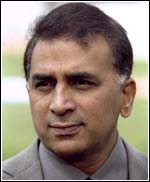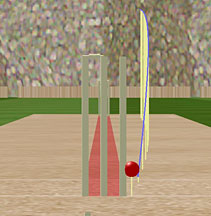 Home > Cricket > Diary archives
Home > Cricket > Diary archivesAugust 24, 2001
The men in the muddle
Prem PanickerWhile following the ongoing India-Sri Lanka Test series, I've been struck by the number of times television commentators have -- within seconds of the onfield umpire giving a decision -- called for television replays, which in turn have cued them into astringent comments on the umpiring.
And while watching that, memory flashed back to the second innings of the second Test between India and Zimbabwe at Harare. VVS Laxman played an uppish cut, if you recall. A catch was claimed, and given.
'I'd like to see that again," was the immediate reaction of the television commentator.
So, courtesy the Star Sports television crew, he got to see it again. And again.
"If that had gone to the third umpire, I don't see how it could have been given out," was the verdict.
Another day, another incident. This time, West Indies wicket-keeper Ridley Jacobs pulled off a stumping during the final one dayer of the league phase. The umpire gave his decision, and Virender Sehwag's innings was terminated.
Problem was, as you probably recall, Jacobs had the ball in his left glove, but broke the stumps with the right glove, which at the time was not in contact with the ball.
For what was seen as an act of cheating, Jacobs was handed out a three-match suspension. How, you wonder, does that compensate Sehwag for the unfair termination of his innings? And what action was taken against the on-field umpire for not referring the decision to the third umpire?
 Those points, however valid, are not what this diary is about, however. What intrigued me at the time was that the television commentator, on both occasions, was Sunil Gavaskar. Who also wears another hat -- that of chairman of the ICC's Cricket Committee (Playing).
Those points, however valid, are not what this diary is about, however. What intrigued me at the time was that the television commentator, on both occasions, was Sunil Gavaskar. Who also wears another hat -- that of chairman of the ICC's Cricket Committee (Playing).
It was in that second capacity that Gavaskar, and the CCP, had earlier that same month put a hold on any further use of technology to aid umpires.
They considered various innovations, including the Hawk Eye device which takes the benefit of doubt out of LBW decisions and makes them ironclad. And then they decided not to use the technology. "We decided to hasten slowly," was how Gavaskar put it at the time.
Those who argue the case for freezing technological inputs in umpiring decisions have an emotional line to back up their arguments. To wit: "Any further use of technology will reduce the on-field umpires into nonentities, into glorified coat-hangers for the sweaters of the bowlers."
The concern shown for the feelings of on-field umpires is touching. Or would have been, had television and its commentators not been singularly responsible for reducing said umpires into the much-villified figures they are today.
On the one hand commentators -- almost all of them ex-internationals of stature -- talk of the sanctity of the umpire's decision. And on the other hand, they are the first to call for replays, and to then meticulously point out -- several times a day what is more -- how horribly wrong the umpire was, and what a twit he had to have been to give the caught behind when the ball had clearly brushed the batsman's backside and not his bat.
 Simultaneously, the images and the pithy commentary are being flashed on big screens that now adorn cricket stadia around the world, so that the crowds watching are left in no doubt about the umpire's folly.
Simultaneously, the images and the pithy commentary are being flashed on big screens that now adorn cricket stadia around the world, so that the crowds watching are left in no doubt about the umpire's folly.
In other words, today technology can be, and is, used to undermine the authority of the umpires. Surely you, too, have seen how, time and again, batsmen and bowlers glance up at the big screen as soon as the umpire gives a verdict?
Technology can be used to show up the umpires as incompetent: "I'd like to see that again!"
Technology, in tandem with television, can be used to ensure that no player, no spectator, takes any decision given on the field of play without a bag of salt.
But when it comes to using that same technology to help an umpire, what you get is a horrified 'Nooooooooooo, how can we do that, think of the poor umpire's feelings!'
That's right, let's think of his feelings. If you want to maintain the umpire's pre-eminent position, do away with the giant screens in stadia, stop calling for those action replays, mandate that commentators should not refer to erroneous umpiring decisions.
If 'the umpire's decision is final' -- as players are supposed to believe -- then so be it. Let it be final, not merely the prelude to cleverness from the commentary team. And let that be uniform for all -- be it players, fans, commentators, media reporters, whoever, let us all be bound to respect the umpire's decision as final, and leave it at that.
Let the man in the middle be given back the unchallenged authority that was his before multiple camera angles, slo-mo replays and all the rest of it came into play to convert him into the muddler in the middle.
And if you can't do that, then for god's sake, help the guy out, give him the technology and let him use it to make sure that his decisions will not provoke comment and criticism.
Why is it that we do not use all this technology to help the umpire make the right decisions, instead of using it merely to have fun at the umpire's expense?
Also read:
Can new technology help the umpires?
Yesterday's diary: Another false promise
The Rediff Email Diary -- the complete archives
![]()
![]()
Email : Prem Panicker
©1996 to 2001 rediff.com India Limited. All Rights Reserved.